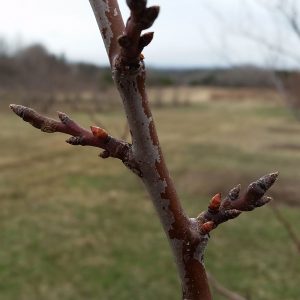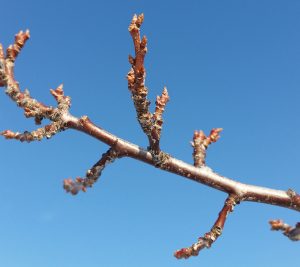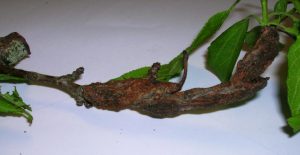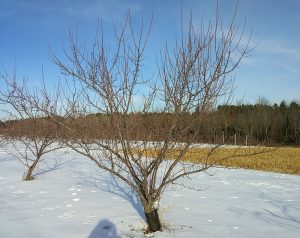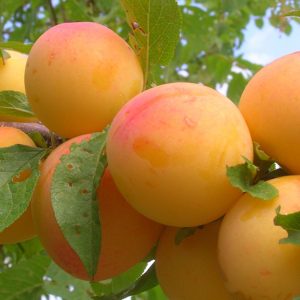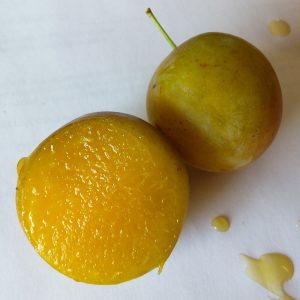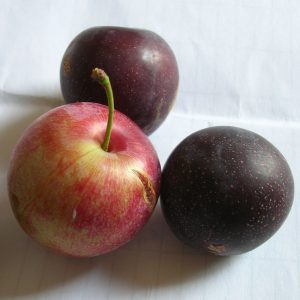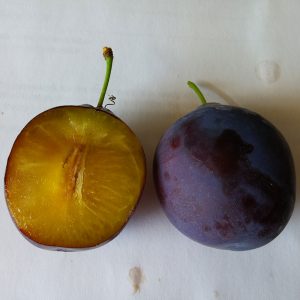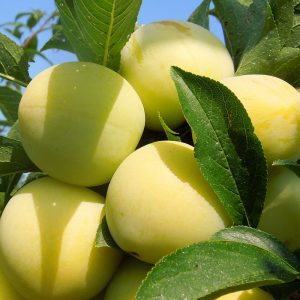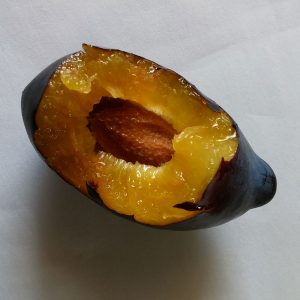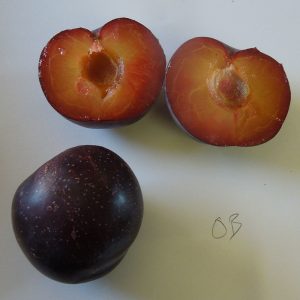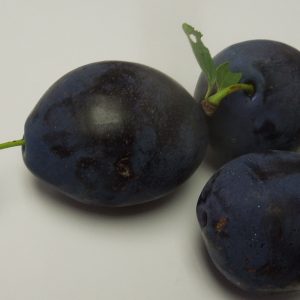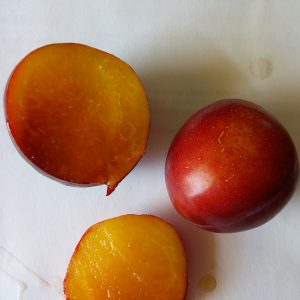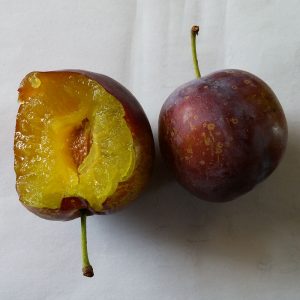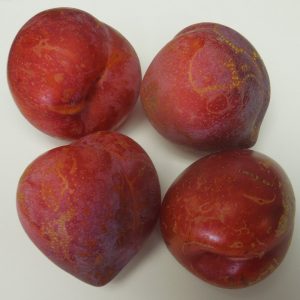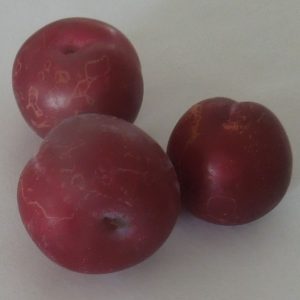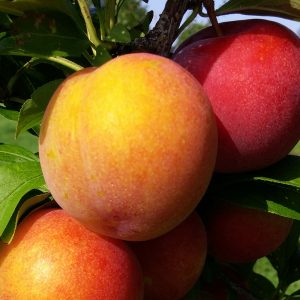Bulletin #2034, Plum Production in Maine
By Renae Moran, Tree Fruit Specialist, University of Maine Cooperative Extension
For information about UMaine Extension programs and resources, visit extension.umaine.edu.
Find more of our publications and books at extension.umaine.edu/publications/.
Table of Contents:
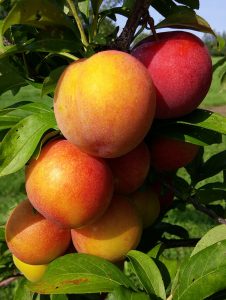 Expected Yield
Expected Yield- Estimated Production Costs
- Selecting Varieties
- Table 1. Important traits of Japanese plum (Prunus salicina) varieties, listed in order of ripening.
- Table 2. Important traits of European plum (Prunus domestica) varieties, listed in order of ripening.
- Rootstocks
- Table 3. Characteristics of plum rootstocks.
- Adaptation to the Climate
- Planting
- Fertility
- Table: Fertilizer nitrogen need (lbs. per acre) based on tree type and nitrogen content of the soil.
- Table: Purity of commonly used fertilizers and rates needed to obtain 1 lb. of pure nutrient.
- Table: Fertilizer potassium need (lbs. K2O per acre) for fruit trees based on leaf and soil testing in established orchards.
- Pollination
- Fruit Thinning
- Common Diseases
- Insect Pests
- Calculating Tree Row Volume (TRV)
- Table: Tree-row-volume in gallons per acre for common row spacings of plums.
- Pruning
- Common Problems
- Harvest and Storage
- Plum Varieties and Descriptions Listed in Order of Ripening
The resurgence in demand for locally-grown fresh fruit has created an opportunity for Maine’s famers to grow and sell plums. Many varieties of plums with excellent fruit quality and market potential are adapted to Maine’s cold climate. As a summer fruit, they are ready to harvest when most farmstands are open for business and people are seeking local produce. The cultural requirements and production practices of plums are similar to apple trees, so farm operations can be easily adapted for plum production.
Farmers who plan to establish a plum orchard should consider how the cultural requirements of plums will affect their operation. To extend the marketing season, a plum orchard should consist of numerous varieties that ripen over several weeks from late July through October. As a tree fruit, they require additional labor and have a short market window compared with apples. Currently, orchard size is generally much smaller than for apple trees, ranging from several trees to half an acre.
Expected Yield
Plums generally begin to bear fruit in the third year after planting and attain full production about eight years after planting. Because of their large size at maturity, plum orchards have a long establishment phase during which trees have not fully grown into their allotted space. Planting trees closer together to achieve high tree density has not been researched for plums.
In a high-yielding year at full production, yield can range from 10,000 to 20,000 lbs. per acre, depending on the variety. The average yield in a good year is about 12,000 lbs. per acre or about 50 to 80 pounds per tree depending on tree size. Reductions in yield occur from winter injury, spring frost, rain cracking, insect pests, and disease. In some years, yield losses can be severe, occurring on the average about twice every ten years for Japanese plums and less frequently for European plums. Rain cracking and winter damage to flower buds are the primary causes of yield reductions, so the selection of varieties should be based on these traits as well as marketability and consumer acceptance.
Estimated Production Costs
Establishment costs for a typical semidwarf plum orchard can be expected to range from $4000 to $5000 per acre for site preparation, trees, supplies, and labor (measured in 2015). As a self-supporting tree, there is no need for a trellis, so establishment costs are lower than for apple. Crop protection costs for spray materials on an annual basis are similar to apples and can range from $600 to $800 per acre (measured in 2015). Labor is a substantial cost of fruit production. The labor requirement for pruning, mowing, and spraying will be similar to semidwarf apples, but for fruit thinning and harvest, labor costs can exceed what is needed for apples. An estimated labor cost for plums is about $2000 per acre each year that trees produce a full crop.
Selecting Varieties
With many different plum varieties (Table 1) available, consider winter hardiness and disease resistance for easier management, and fruit quality and ripening date for easier marketing.
There are two general types of cultivated plum that vary in eating quality and when they ripen. Most Japanese plums ripen in summer. They have a juicy texture and an intense fruity flavor. The varieties vary considerably in fruit size and color. Colors vary from yellow to red to dark purple in the skin and flesh. European plums ripen from the end of summer into fall. Their flavor is much sweeter, but the texture is more firm than Japanese types. They are generally yellow or purple-skinned with yellow flesh.
For easy management, plant varieties according to ripening date within the orchard. Early varieties may need to be harvested before the final insecticide spray since late-ripening varieties can be attacked by apple maggot and spotted wing drosophila if left unprotected. Interplanting varieties that ripen at different times can lead to yield loss due to insect damage.
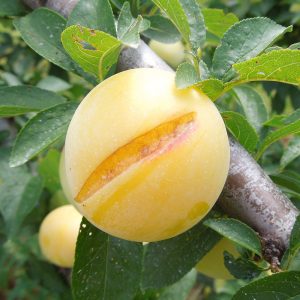
Yield loss occurs in many varieties when heavy rain occurs as fruit ripen. Shiro, Methley, and Superior are very susceptible to rain cracking. Despite high yield in these varieties, large yield losses can occur in years with frequent and heavy rain in summer. Other varieties with a greater chance for rain cracking are Elephant Heart and Cambridge Gage.
Rootstocks
Few choices of rootstocks exist for plums, and most lack the size-controlling capability of dwarfing stocks. As a result, plum trees are standard or semidwarf in size. However, the root systems of plum rootstocks are sufficiently strong to support the tree without additional help from stakes or trellising. The cost of establishing a plum orchard is consequently low compared to high-density apple orchards. Plums are graft compatible with several of the peach rootstocks, such as Citation and Lovell, but most peach rootstocks are not as hardy as plums.
Cold hardiness of plum rootstocks is generally sufficient for south and central Maine. Americana rootstock is preferred for northern Maine but may be incompatible with some varieties. All plum rootstocks produce root suckers in abundance.
Methley and Early Golden are very vigorous varieties with a spreading growth habit and require additional spacing in the orchard. Shiro, Obilinaja, and Abundance have medium vigor and a spreading growth habit. Superior is low in vigor. Toka and Vanier are vigorous, but with an upright growth habit allowing for closer tree spacing.
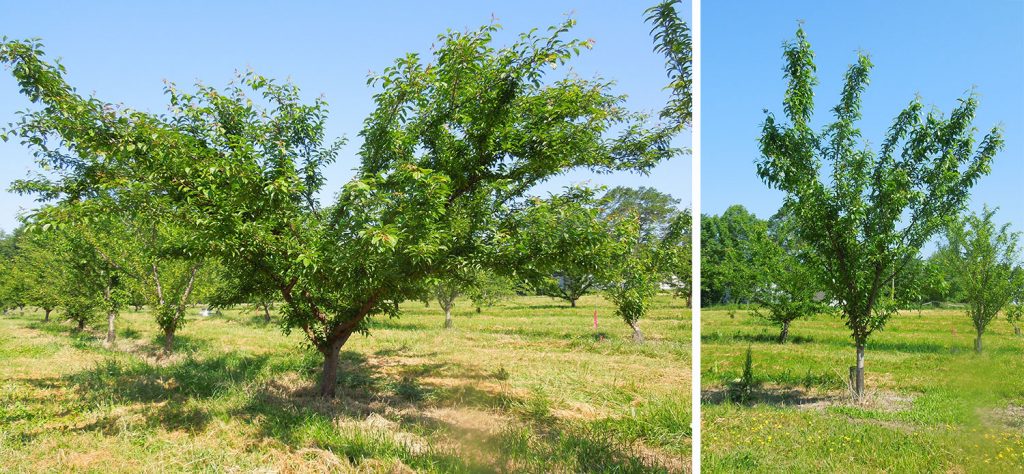
Adaptation to the Climate
Most Japanese plums have sufficient winter hardiness to survive in southern Maine, but the most tender varieties should be avoided. Fluctuating temperatures in winter and early spring also cause freezing damage in some varieties. Methley and Early Golden have exhibited this trait in southern Maine. Winter damage commonly kills flower buds in tender varieties and is a leading cause for low yield. Tree trunks and branches can also be damaged by cold temperatures
Most plum varieties will fail to survive the northern-most regions of the state. North of Bangor, growers should consider varieties that have been bred to be adapted to hardiness zones 3 and 4 (-20 to -40°F), such as Superior, Alderman, Toka, Black Ice (Lydeker), and South Dakota.
European varieties have good hardiness in most of the state but are generally more susceptible to the disease black knot than Asian plums.
Plums bloom one week before apples. An early bloom date, usually mid-May, makes them more susceptible to frost damage. For this reason, they should be planted in sites with good air drainage so they can escape the worst spring freezes. Pollination can be problematic when bloom coincides with poor weather. An added measure to ensure good pollination is the placement of beehives in the orchard during bloom. For apple growers, this involves planning ahead to have hives delivered several days earlier than for apple trees.
Planting
When selecting a site for an orchard, higher elevation and good airflow are preferable to lower ground or areas that are protected from the wind. The higher elevations tend to be warmer during radiative frosts and freezes. Ideal sites occur on sloping land that is not surrounded by dense woodlots. On these sites, cold air can flow down to the lower ground during radiative frosts when temperature inversions occur.
All fruit trees need full sun for the development of flower buds and for maximum winter hardiness. To be considered “full sun,” a site must receive a minimum of six hours of direct sunlight each day.
Fruit trees thrive in well-drained soil with a pH in the range of 6.0–7.0. Soil testing is essential for determining any pH and fertility adjustments needed such as lime, phosphorus, potassium, and micronutrients. Soil samples can be processed by the University of Maine Analytical Lab and Maine Soil Testing Service in Orono. When more than 3000 lbs. of lime is needed for pH adjustment, it is best to apply 2/3 of the total amount before planting and the remainder two years after planting. Large quantities of lime applied at one time can create a nutrient imbalance in the soil.
Zinc and phosphorus are difficult to correct after planting because they fail to move into soil. Zinc sulfate can be ground applied and incorporated into the soil prior to planting, but information on rate optimization is lacking. To prevent toxicity, apply no more than 10 lbs. of zinc sulfate (36% elemental Zn) per acre and thoroughly incorporate it before planting. Rates of preplant phosphorus (P2O5) to incorporate range from 40 to 120 lbs. per acre depending on soil test results.
Just prior to planting, roots can be soaked in water for 15 minutes to an hour. Avoid adding fertilizers or other materials to the planting hole since they can damage roots. Microbial inoculants such as mycorrhiza are applied directly to roots at planting, but benefits have been inconsistent in research trials.
The optimum tree spacing depends on variety, rootstock, soil fertility, and training system. Plum varieties vary in vigor and final tree size. Methley and Early Golden are very vigorous and should be planted 15 feet within the row in most soils, and 16 to 18 feet in deep, fertile soil. Shiro is intermediate in vigor and can be planted 12 feet in the row. Some varieties have an upright growth habit that requires less space despite strong vigor. Vanier and Wickson can be planted 10 to 12 feet in the row, and closer in sandy soils. These are suggested tree spacings for orchards in Maine and for trees on Myrobalan rootstock, the most common rootstock for plum. For high-density training systems such as the perpendicular V, or with size-controlling rootstocks such as Krymsk1, trees can be planted a few feet closer.
Fertility
Tree growth, flowering, fruiting and cold hardiness are all affected by soil fertility and the nutrient status of the tree. Since root uptake from the soil is the primary source of fertility, fruit trees are commonly supplied with fertilizer applied to the ground. Deficits occur in soils low in organic matter or when the soil temperature is too low for microbial decomposition in early spring. However, some nutrients are provided by minerals stored in bark and wood. Trees store nutrients and reuse them with renewed shoot growth in spring, so rates of fertilizer are more conservative than for row crops such as corn.
Nitrogen. May is the best time to apply nitrogen fertilizer, during the time of greatest shoot growth. Reserve nitrogen, stored inside the tree, supplies nitrogen for early shoot and fruit growth but is rapidly depleted. A nitrogen deficit may exist in spring when soil supply is low or deficient. By summer, the demand for nitrogen decreases, and fertilizer added at this time is detrimental to fruit quality.
Nitrogen (N) promotes normal shoot growth and large fruit size but can impair fruit quality and cause excessive shoot growth when applied in large amounts or during summer. It is best to be conservative with nitrogen fertilizer since deficiencies are quickly and easily corrected, but excesses are corrected only with time. Most of the nitrogen requirement can be supplied by the soil, but sandy soils typically require additional fertilizer. Soils high in organic matter may not need additional nitrogen fertilizer. A soil test can determine the general fertility for long-term planning but is not precise since the level of available nitrogen changes through the season. To determine the need for nitrogen fertilizer, foliar analysis performed annually is a more precise assessment than a soil test. With time and experience, nitrogen fertilizer need will become apparent from annual leaf tests and tree performance.
In warmer parts of the US where the growing season is long and trees are large, plum trees use as much as 150 lbs. N per acre each year. In Maine, it is expected that less nitrogen is needed because of the smaller tree size and shorter growing season. Most of the nitrogen is supplied by the soil, 30 to 80 lbs. N per acre each year depending on soil type and organic matter content. Soils high in organic matter will supply more nitrogen than sandy soils. When a leaf test indicates low nitrogen, part of the nitrogen can be supplied by fertilizer, usually 10 to 60 lbs. per acre.
Manure provides a significant amount of nitrogen in the year it is applied, but only small amounts in subsequent years. Due to its variable nature, it provides an imprecise amount of nitrogen and other nutrients. Soil incorporation before planting is the easiest and safest method of using manure to improve fertility, but it should be aged or composted to prevent burning of plant roots. The Food Safety Modernization Act limits the time when manures can be used in fruit-bearing orchards.
(Adapted from Stiles and Reid, 1991)
Phosphorus. Established trees do not respond to phosphorus fertilizers since it does not move into the soil. It is best to apply phosphorus prior to planting and incorporate it into the top soil. In established orchards, maintaining soil pH above 6.0 will improve phosphorus availability.
Fruit trees require large quantities of potassium. Potassium is a critical nutrient for fruit growth and color, and also contributes to good winter hardiness. Fruit trees take up 125 to 175 pounds of potassium per acre each year and nearly half of which is in the fruit and is removed at harvest. European plums can experience deficiency symptoms when bearing a heavy crop. As soil becomes depleted, fertilizers can be added, typically on an annual basis since potassium may take several years to move into the soil.
Soils with less than 250 lbs. per acre of K20 are considered low to deficient. In Maine, orchards soil levels range from less than 100 lbs. per acre up to 600 lbs. per acre with an average of about 250 lbs. / acre. In orchard soils with low potassium, annual applications of about 100 lbs. potash (K20) is sufficient to maintain adequate potassium supply in the soil. However, the choice of fertilizer will depend on both the potassium and magnesium content of the soil. When magnesium is low, potassium-magnesium-sulphate fertlizer maintains the balance of these two minerals. Applying large amounts of potassium without also adding magnesium usually leads to magnesium deficiency. Stone fruit are sensitive to the chloride in potassium chloride, another reason to use potassium-magnesium-sulfate.
Magnesium. A soil test level of 200 to 500 lbs. per acre is considered adequate at planting. Most orchards in Maine have low foliar test levels. To correct this, a spring foliar application of magnesium sulfate (Epsom salts) is sufficient. Potassium fertilizer can lead to a soil imbalance, so potassium-magnesium-sulfate is commonly used to prevent magnesium deficiency. High rates of ammonium nitrogen (NH4+) fertilizer can also interfere with magnesium uptake. Epsom salts can be foliarly applied with sprays beginning at petal fall.
Calcium is essential for good winter hardiness and fruit integrity during harvest and marketing. Since plums are sold within weeks of harvest, calcium content of fruit is not as critical as for apple and pear. Maintain soil pH near 6.5 to ensure adequate uptake from the soil.
Boron. The micronutrient boron is essential for normal root growth, pollination and fruit growth, but plums and other stone fruit require less boron than apples and pears. High rates of boron fertilizer can cause boron toxicity which shows up as poor fruit set and small holes in foliage along the midvein. Foliar analysis is the most effective method of determining boron status in an orchard. Foliar levels should be below 60 ppm to prevent toxicity. In orchards with foliar levels below optimum, a foliar application in spring at a rate of 0.5 lb. per acre of actual boron is sufficient for correction. Ground applications at the same rate will also correct deficiency. Commonly used boron fertilizers contain 5 to 21% boron. Foliar application of boron in spring will correct the deficiency, but rates should be lower than for apple trees. Boron fertilizer should not be tank mixed with calcium-containing compounds or spray materials in a water-soluble plastic pouch.
Before planting trees, two nutrients that are immobile in soil, phosphorus, and zinc, should be added and tilled into the soil. These two nutrients will not move readily into the soil without deep tillage. Deficiencies in phosphorus and zinc should be corrected prior to planting. When a soil test indicates zinc insufficiency, zinc sulfate (36% zinc), can be added in small quantities, 4 to 10 lbs. per acre to avoid toxicity, but little research has been done to confirm rates for fruit trees. Potassium, magnesium, nitrogen, and boron can be adjusted prior to planting, but can also be added afterward once the rain has settled the soil while avoiding direct contact with the trunk. Calcium nitrate is less likely to burn tree trunks and exposed roots in loose soil, and is also less likely to be lost to the atmosphere in warm weather.
In established orchards, annual foliar analysis becomes an important tool in determining fertilizer needs. The best time to collect leaves is mid-July as shoot growth ceases. Expect fluctuations from year to year in leaf levels since soil moisture and crop load affect the amount of shoot growth. In years with more shoot growth, leaf levels of nitrogen are lower since nitrogen is diluted among a greater number of leaves. In years with a light crop load, the same thing happens.
Instructions for collecting a leaf sample for nutrient analysis.
- Samples should be collected in mid to late July. Samples collected too soon or too late will have invalid nitrogen levels.
- Samples should contain leaves from only one variety. Different varieties should be sampled separately, if possible.
- Select trees in good health that are typical of the orchard in tree size, age, crop load, and vigor. Avoid leaves from weak or sick trees. Avoid yellow leaves on the apple variety Honeycrisp.
- Collect 50 to 100 leaves from this year’s shoot growth. Pick leaves that are midway down the shoot from shoots that are one to two feet in length, if possible.
- The ideal block size is 10 acres or smaller. However, larger areas can be sampled when tree age, crop load, weed control and soil fertility are the same from one end to the other.
- Leaves can be dried before submitting them to the soil testing lab.
Soil pH and Liming. Soil pH has a large effect on nutrient status since elements become difficult to absorb when pH is above or below the optimum. Optimum soil pH for fruit trees is 6.5. Soil pH below 6.0 is unsuitable for fruit trees as is a soil pH above 7.5. In the northeast, most soils are slightly acidic.
Soil pH can be raised by agricultural lime. Calcium carbonate, dolomite, calcium hydroxide, and calcium oxide are commonly used liming materials. Liming materials work best when incorporated into the soil, so pH adjustment is easiest before trees are planted. Adding lime after orchard establishment will also be necessary, but the pH changes slowly when lime is applied after planting. The amount of lime needed to adjust pH to optimum is determined with a soil test. Most soil testing labs will provide a recommendation in pounds of lime per acre.
When more than 2000 lbs. per acre of lime is needed in an established orchard, apply it incrementally over a period of two to three years to avoid creating nutrient imbalances in the soil. Apply no more than 2000 lbs. per acre each year. Prior to planting, up to 4000 lbs. per acre can be soil incorporated in one year.
In many orchards, soil pH gradually decreases with time. This is partly due to the addition of nitrogen fertilizers such as ammonium nitrate and urea. Calcium nitrate does not lower soil pH, and maybe the best choice for fruit trees in acid soils.
Pollination
Most plum varieties require cross-pollination by another variety. However, there are two types of plums, Japanese and European, and they are not cross-compatible. European plum will not pollinate Japanese varieties and vice versa. In addition, there are some varieties of Japanese plum that will not cross-pollinate other Japanese plums. At this time, it is uncertain which combinations work best, so planting additional varieties is recommended. When planning an orchard of Japanese plums, select at least three varieties to maximize cross-pollination. European plums also require cross-pollination by other European plums. Knowledge of cross-incompatibilities between European varieties is scant.
Trees planted in an orchard as a source of pollen for another variety are called pollenizers. Based on observations and testing, Vanier, Wickson, and Early Golden appear to be good pollenizers for other Japanese varieties. Toka and Superior appear to be compatible with each other. To simplify spraying and harvest, group all trees of one variety together within the orchard. In established orchards where it is not possible to add more varieties, individual limbs of trees can be grafted to other varieties.
Plums bloom one week before apple trees, so the arrival of rented bee hives for apple trees is generally when plums are at the petal fall stage. Therefore, native bees serve as the primary pollinators of plums. Few other plants bloom at the same time as plums, so competition for native bees is not as great as for apple trees. In addition, plum orchards are small, so native populations may be sufficient to cross-pollinate plum blossoms when the orchard is near pasture. Where rented hives are not used for plum pollination, maintain healthy native bee habitat to ensure a large population for plum plantings larger than one acre. Meadows with an abundance of flowering plants provide a good source of nectar through the spring and summer, but meadow voles will also thrive in this habitat if it is not mowed in late summer and fall.
Fruit Thinning
When pollination is good, trees can bear an excessive amount of fruit, which leads to poor flavor and small fruit size. In addition, limbs may not have the structural strength to support all of the weight of the fruit and consequently can break off near harvest time. To counteract this problem, some of the fruit should be removed in mid to late June, but fruit thinning in July will also be beneficial. Thinning fruit early in the growing season will benefit the tree more than fruit thinning closer to harvest. Remove fruit so that the remaining ones are spaced about 3–4 inches apart along the branch.
The time required to adequately hand thin plums varies considerably from year to year and between different varieties. The varieties Shiro and Early Golden varieties tend to overset fruit every year and require about 15 hours per acre for hand thinning with experienced workers. The variety Vanier generally sets fewer fruit each year and requires 5 to 10 hours per acre of hand thinning labor.
During dormant pruning, spurs with flower buds can be removed to reduce potential crop load.
Common Diseases
Plums are susceptible to several diseases that occur in Maine. Selection of resistant or tolerant varieties is the most effective method of prevention, but chemical fungicides can prevent crop loss.
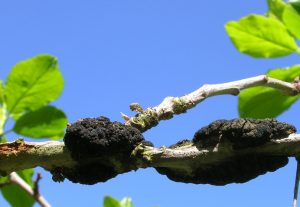 Black Knot
Black Knot
- Black knot infections occur in the springtime during the active phase of shoot growth when rainfall favors the spread of this fungus. Wild cherry and plum serve as alternate hosts, spreading the disease to cultivated plums and making chemical control more difficult in susceptible varieties.
- This disease is common in plum orchards. Symptoms appear in new shoots as green swellings of the stem and oddly shaped growths covering the shoot that eventually turn black with a warty surface. In severe cases, the fungus girdles the branch. Cultivated plums vary in susceptibility with Stanley and Methely being highly susceptible, and Obilinaja fairly resistant.
- The most important period for black knot sprays is from white bud to shuck split. Infections require rain and are favored by temperatures above 55 F.
Disease Cycle and Management
Black knot is caused by the fungus Dibotyron morbosum, also known as Apiosporina morbosa. It overwinters on infected trees and is common on wild cherry and wild plum, as well as, ornamental stone fruit species. Dispersal occurs from ascospores released during rain beginning soon after bud break at the green cluster stage and continues throughout shoot elongation which continues into summer, but most occur just before and during petal fall. Symptoms become visible in fall. Initially, infections appear as green swellings on new shoots, but they eventually turn black in their second year. Elongated swellings that can vary in length from 1 to 12 inches. Because of their green color, it is easy to miss infections in their first year. The knot continues to develop through the second summer with ascospores maturing the second winter after infection.
Infections will affect the woody part of the tree, so with a severe infestation, there is a yield reduction. Once established in an orchard, it is difficult to control solely by chemical means. Well-time fungicide sprays can prevent infection. However, where wild infected hosts are near the orchard, complete control is not possible in susceptible varieties. In this case, infections should be removed during dormant pruning by cutting back several inches into healthy tissue.
Activity Rating of Fungicides:
- Copper — slight
- Captan — good
- Chlorothalanil (Bravo, etc.) — excellent
- Sulfur — none (ineffective)
- Thiophanate-methyl (Topsin M) — fair
Nonchemical control is primarily by removing wild plum and cherry, and by removing infections during pruning. Where this is not possible, select varieties with partial to complete resistance:
- Spring Satin plumcot
- Obilinaja
- Early Italian
- Green Gage
- Fellenberg
- President
Brown Rot
- Strong resistance to brown rot does not exist in commonly grown varieties, but plums are generally not as susceptible as peaches. However, European plums are more susceptible than Japanese plums.
- The brown rot fungus infects flowers when wet weather occurs during bloom and infects fruit when warm, wet weather occurs during the ripening stage. Infected fruit that is not harvested will dry and persist into the next season to continue the spread of infections, and should, therefore, be removed during dormant pruning.
- Fungicides applied to protect blossoms and ripening fruit should be timed according to susceptibility and weather that favors disease.
Disease Cycle and Management
Brown rot, a fungal disease caused by Monilia fruiticola, infects blossoms, shoots, and fruit, and causes significant losses for growers when not controlled. Plums are less susceptible to brown rot than peaches and cherries but can be severely infected when conditions are ideal for the fungus. The brown rot fungus overwinters on mummified fruit that remains attached to twigs, infected blossoms that cling to twigs and on infected shoots. Fungal conidia are dispersed by wind and rain. The disease is more severe with wet weather.
Conidia produced on infected blossoms and shoots spread to fruit. Infected blossoms wilt, turn brown and cling to the shoot. The infection can move into the twig and cause a canker. Blossom infections are not common on plum.
During the two to three weeks prior to ripening, fruit becomes susceptible to infection. Immature fruit can be infected when insect control is poor. Signs of infection begin as small, tan colored circular lesions on the fruit surface. In warm, humid weather, lesions develop conidia, a mass of grayish brown spores over the fruit surface. During warm, humid conditions, grayish brown spores are produced which can be diagnostic of brown rot. Infected fruit that remains in the orchard will shriven and cling to the branch, and serve as a source of the disease the following spring. These shriveled “mummies” should be removed during pruning.
The brown rot fungus can be spread by insects and can also spread from alternate hosts such as wild plum and cherry. Improve air circulation with annual pruning and sucker removal. Hand thin fruit before pit hardening, so that fallen fruit decay in advance of fruit ripening. Thin fruit so that they are not in contact with other fruit. Harvest fruit before they become overripe.
Fungicide resistance has occurred.
Activity Rating of Fungicides:
- Copper — not applicable
- Captan — good
- Chlorothalanil (Bravo, Echo) — excellent for blossom blight, not labeled for fruit rot
- DMI (Indar, Tebuzol, etc.) — excellent, except for Rally
- Strobilurin (Pristine, Gem, etc.) — excellent
- Sulfur (Microthiol Disperss, etc.) — fair for blossom blight, slight for fruit rot
- Thiophanate-methyl (Topsin M) — not recommended because of resistance
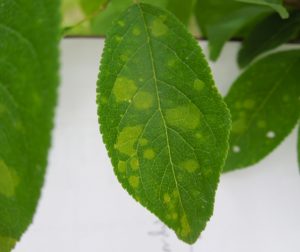 Bacterial Leaf and Fruit Spot
Bacterial Leaf and Fruit Spot
The foliage and fruit of many plum, peach, and apricot varieties is susceptible to infection by bacterial leaf spot, Xanthomonas arboricola, that causes small yellow spots and a shot-hole appearance in foliage summer. Fruit infection leads to round, sunken spots that detract from the appearance and marketability of fruit. These symptoms can be confused with spray injury. Warm weather and moisture favor its spread as do nearby susceptible peach and apricot trees. Other names for this disease are bacterial shot hole and bacteriosis.
Plum and peach varieties vary in susceptibility. Shiro and Early Golden have a high degree of susceptibility. Obilnya and Vanier have some resistance. In general, European plums are more tolerant than Japanese varieties. The most effective management strategy is to plant resistant varieties since chemical sprays are of limited use in preventing this disease.
In early summer, signs of bacterial leaf spot first appear as water-soaked spots on the leaves. The shape of the spots is more angular than round. They eventually turn yellow and fall out which creates the shot-hole appearance. The shot-hole effect is more pronounced on plum than peach, whereas in peach, the lesions turn brown with extended areas of yellowing. Fruit infections lead to sunken spots that easily crack with fruit expansion.
Copper sprays are more effective for prevention than control and are of limited use due to phytotoxicity. Consequently, planting resistant varieties is the most effective management strategy.
Bacterial Canker
Cankers on plum trees are common and occur after winter injury. Following winter injury, tissues can easily be invaded by several pathogens that cause cankers. Branches with cankers can be removed during normal pruning. When cankers occur on the trunk, removal becomes difficult without damaging the tree. Oozing of sap is a sign of winter injury or disease, but in many cases, the tree eventually recovers.
Insect Pests
Plum curculio, a snout weevil, attacks young fruitlets as they begin to grow to the size of one-half inch in diameter. The plum curculio adult lays eggs directly into the fruit during a period of five to seven weeks after bloom. In the process of egg laying, the curculio creates a 1/4-inch crescent-shaped scar on the fruit surface. Infestation leads to fruit drop in most cases, so orchards that are not protected by insecticide can lose a considerable number of fruit to this pest. Protectant or repellent sprays begin after petal fall and continue into July.
Apple maggot occurs in abundance in the northeast. Adult flies lay eggs in fruit during summer, so damage occurs because of fruit larvae feeding within ripening fruit. Traps, red spheres coated with a layer of sticky gel called Tangletrap™, can be used to trap and monitor populations and to measure when thresholds are reached. Because populations vary from orchard to orchard, traps can be used to determine when insecticides are most effective or not needed. Populations are most abundant near unsprayed apple trees.
Spotted wing drosophila, a fruit fly, can attack ripe fruit. Avoid leaving fully ripe fruit on the tree or in the orchard to minimize damage. Insecticides applied for apple maggot may also protect the fruit from spotted wing drosophila.
Other pests, such as codling moth and oriental fruit moth, are likely to be present in the orchard and are generally managed by insecticide sprays applied to control plum curculio and apple maggot.
Calculating Tree Row Volume (TRV)
Volume in gallons of water needed to spray an acre of the orchard to the drip point is known as the tree-row-volume. It varies from 400 gallons per acre for old-fashioned standard-size apple trees at the full canopy to about 75 gallons per acre for dwarf trees with thin canopies. Tree-row-volume ranges from 200 to 300 gallons per acre for semidwarf plum orchards.
This exercise calculates the number of gallons per acre for a dilute spray or the spray volume needed in order to completely cover the foliage and fruit. Begin by measuring the tree height and canopy spread, assuming that it will increase over the course of the growing season. Most plum trees are similar in size to semidwarf apple trees, but with an inverted shape so that the majority of the canopy is in the upper half of the tree canopy.
Plum tree height varies from six feet for weak trees in poor soil up to 16 feet for vigorous trees at the end of the shoot growth phase. Common tree spacing is 12 to 15 feet in the row and 18 to 22 feet between rows. The steps in calculating TRV for a semidwarf orchard are as follows:
1. Row-feet per Acre
43,560 ÷ row spacing
e.g. 43,560 ÷ 20 = 2178
2. Cubic Feet of Tree-Row-Volume
row-feet per acre x tree height x cross-row tree width
e.g. 2178 x 13 x 13 = 368,082
3. Density Factor
Select the right canopy density factor which ranges from 0.7 for open, well-pruned canopies to 1.0 for lightly or unpruned trees with thick canopies. The density will also increase from a thin canopy before bloom to a thicker canopy after petal fall as the trees leaf out and grow new shoots.
e.g. 0.9 gallons per 1000 cubic feet for a full canopy in mid summer
4. Tree-Row-Volume in Gallons per Acre
cubic feet of TRV x density factor ÷ 1000
e.g. (step 2 x step 3) ÷ 1000
368,082 x 0.9 ÷ 1000 = 331 gallons per acre
Along with sprayer calibration, the calculated tree tree-row-volume is important for accurately and effectively spraying an orchard. For additional instructions on orchard spraying, consult the New England Tree Fruit Pest Management Guide.
Pruning
Pruning is one of the costliest practices but is essential in order to correct the natural tendencies that lead to inefficiency and lack of production. A mature orchard can be pruned in as little as 20 to 30 hours per acre with an efficient pruning system and experience. However, 60 to 80 hours may be needed for someone who is still learning to prune or if trees have not been pruned annually.
Pruning prevents fruit trees from growing to an unmanageable height and into neighboring trees. As trees reach their tallest manageable height and width, they should be pruned to remain at this size so that harvest and spraying remain feasible. Shoots need sunlight for flower bud formation and fruit growth. Pruning removes branches that shade lower shoots so that most of the foliage receives sufficient sunlight. Pruning is also a technique for managing crop load when trees form too many flower buds. In this case, pruning some of the spurs and short shoots reduces their number and saves on subsequent fruit thinning.
Plum trees are typically trained and pruned using a multiple leader system. To prevent trees from growing too tall, two to six leaders are trained at an outward angle rather than upright. However, some varieties are strongly upright in growth habit and may not easily conform to this training. The vase-shaped training preferred is preferred for plum because it prevents the development of one strong leader and, thus, results in a shorter tree. Plum shoots can grow as much as six feet in one season. Many variations of the multiple leader system are used for stone fruit, such as the open center, quad V and steep leader.
Tree training begins at planting when the upper part of the main trunk is removed by pruning it at a point just above four or five healthy side branches. Prune off dead or broken branches and ones that are too low on the trunk. Prune the tree as little as possible in the next five years to encourage the formation of flower buds. However, branches growing back into the center of the tree canopy should be removed each year. Trees that have not yet grown side branches or “feathers” can be pruned back to a height of 26 to 32 inches above ground to encourage the growth of strong shoots that will become permanent limbs.

Plum trees begin to bear fruit three years after planting and reach full fruit production seven to 10 years after planting. Young trees less than five-years-old should be pruned as little as possible. In the first few years, pruning removes branches that would ultimately bear fruit. Tipping cuts result in additional leafy shoots that require an additional year to bear flowers and are discouraged for this reason. Thinning cuts are the preferred technique for branch removal and heading cuts into older branch sections for shortening limbs.
Full-grown trees should be pruned to a greater extent than nonbearing trees in order to maintain good production. The specific steps of pruning depend on the selected training system. However, for a multiple leader tree with four to six leaders, annual pruning typically involves three steps.
- Prune leaders back to a height below 14 feet for effective spraying and easier harvest. Prune back leaders by heading them just above a side branch.
- Thin out branches that grow into the center of the tree canopy and the longest shoots in the top of the canopy.
- Thin out branches so that they are spaced several inches apart along with the leaders. Where two branches are within a few inches of each other and growing in the same direction, one can be thinned out.
The goal of pruning is to ensure that sufficient light can reach the lower branches, and this is accomplished by removing more branches form the upper part than from the lower part of the tree. As lower branches become increasing shaded, they form fewer flowers and can lack winter hardiness. The pruning process reduces cold hardiness in the weeks that follow and should be done in late winter to avoid the coldest winter temperatures.
Selectively pruning some of the spurs and shoots is a method for managing the crop load in years when the tree produces too many flower buds. The number of flower buds formed will vary from year to year and can be excessive in some years. They are distinguished from leaf buds by their shape and location on the shoot. Flower buds occur along the length of last year’s new shoots and spurs. The bud at the tip of each shoot is a leaf bud. It is important to check flower buds for freeze damage before pruning to avoid removing too many following severely cold weather. To determine if flower buds are alive, shoots can be cut, placed in a vessel with water and held at warm temperatures for two to three weeks. Living buds will swell and eventually bloom, whereas dead buds will remain small or drop off. For a quicker method, flower buds can be cut to expose the center so that it can be seen to be either brown (dead) or green (alive).
Common Problems
A number of problems can occur in plum production that reduces profitability by lowering yield or by increasing costs. Some of these problems can be managed by good site selection, irrigation or by planting high-performing varieties, but others such as hail and frost are out of our control. Before planting, consider which are most likely to affect your orchard and take necessary steps to minimize their impact.
Preharvest fruit drop can occur from shortly after bloom up to harvest. Fruit drop that occurs in the month after bloom is caused by lack of pollination, poor choice of pollinizer or by plum curculio damage. The cause for fruit drop that occurs in summer is unknown but is normal and common in young trees. When crop load is heavy, some fruit drop is beneficial.
Rain cracking occurs when heavy rains occur during fruit ripening. As fruit absorbs water, the skin splits, and the fruit becomes unmarketable. Shiro, Methley, Superior, and Elephant Heart are highly susceptible. Some of the gage plums are also prone to rain cracking. When rain is predicted during harvest, fruit can be harvested before they are fully ripe to avoid storms. Plums continue to ripen after harvest once they begin to soften to less than 7 lbs. firmness. An exception is the variety of Shiro, which ripens very slowly after harvest.
Lack of cold hardiness exists in many Asian plum varieties. To avoid tree losses and poor productivity, select varieties that have previously performed well in your region. When selecting varieties that have not yet been tested, plant them in small quantities to minimize losses in the event of tree deaths. Site selection can also reduce winter injury and frost. Orchards located on slopes where cold air can freely move to the lower ground are less likely to experience damaging temperatures than orchards located at the bottom of slopes or orchards surrounded by dense stands of trees.
Low yield as a result of poor fruit set occurs frequently in Japanese plum orchards. This most often occurs because the varieties planted for cross-pollination are not compatible. To counteract this wild trait of plums, plant at least four varieties from within the same species. It is not currently known which varieties are cross-compatible.
Harvest and Storage
Once they ripen, plums and other stone fruit quickly lose quality and soften too much for marketing. Normal storage duration in refrigeration is two to three weeks. Longer storage times reduce fruit quality when stone fruit turn brown or translucent and become stringy or mealy, a condition caused by chilling injury. Because plums have a short shelf life, they should be marketed as quickly as possible. Where this is not possible, cold storage at temperatures near 32°F is recommended.
Sources: Stiles, W.C., and W.S. Reid. Orchard Nutrition Management. Cornell Coop. Ext. Info. Bull. 219.
Fertilizing Fruit Crops, Michigan State University, publication E-852, Eric Hanson, 1996.
Information in this publication is provided purely for educational purposes. No responsibility is assumed for any problems associated with the use of products or services mentioned. No endorsement of products or companies is intended, nor is criticism of unnamed products or companies implied.
© 2017
Call 800.287.0274 (in Maine), or 207.581.3188, for information on publications and program offerings from University of Maine Cooperative Extension, or visit extension.umaine.edu.
In complying with the letter and spirit of applicable laws and pursuing its own goals of diversity, the University of Maine System does not discriminate on the grounds of race, color, religion, sex, sexual orientation, transgender status, gender, gender identity or expression, ethnicity, national origin, citizenship status, familial status, ancestry, age, disability physical or mental, genetic information, or veterans or military status in employment, education, and all other programs and activities. The University provides reasonable accommodations to qualified individuals with disabilities upon request. The following person has been designated to handle inquiries regarding non-discrimination policies: Director of Institutional Equity and Title IX Services, 5713 Chadbourne Hall, Room 412, University of Maine, Orono, ME 04469-5713, 207.581.1226, TTY 711 (Maine Relay System).


